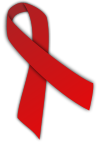Red ribbon: Difference between revisions
Reverted 1 edit by 115.212.92.25 (talk): Rv advert. (TW) |
|||
| Line 5: | Line 5: | ||
==Awareness symbol== |
==Awareness symbol== |
||
[[File:WHredribbonNorthPortico.jpg|right|thumb|220px|A large red ribbon hangs between columns in the north portico of the [[White House]] for [[World AIDS Day]], November 30, 2007.]] |
[[File:WHredribbonNorthPortico.jpg|right|thumb|220px|A large red ribbon hangs between columns in the north portico of the [[White House]] for [[World AIDS Day]], November 30, 2007.]] |
||
The red ribbon is a symbol for both drug prevention and for the fight against [[AIDS]]. The Red Ribbon Foundation [http://www. |
The red ribbon is a symbol for both drug prevention and for the fight against [[AIDS]]. The Red Ribbon Foundation [http://www.aochiworld.com] is an example of an organization that utilizes the red ribbon symbol. The Red Ribbon Foundation is an organization founded in 1993 whose main purpose is the education about prevention of the Human Imunodeficiency Virus or HIV, Acquired Immune Deficiency Syndrome Related Complex, ARC and AIDS. Red ribbon Lapel pins By http://www.aochiworld.com |
||
===Alcohol, tobacco and other drug prevention awareness origin=== |
===Alcohol, tobacco and other drug prevention awareness origin=== |
||
The Red Ribbon was first used as an awareness symbol made by after DEA Agent Enrique S. Camarena was kidnapped, tortured, raped and murdered while working undercover in Guadalajara, Mexico. Citizens in his home town of Calexico, California donned the ribbons to emphasize the need for increased prevention efforts. In 1988, [[Red Ribbon Week]] became a national campaign. |
The Red Ribbon was first used as an awareness symbol made by after DEA Agent Enrique S. Camarena was kidnapped, tortured, raped and murdered while working undercover in Guadalajara, Mexico. Citizens in his home town of Calexico, California donned the ribbons to emphasize the need for increased prevention efforts. In 1988, [[Red Ribbon Week]] became a national campaign. |
||
Revision as of 03:55, 27 January 2012

The red ribbon, as an awareness ribbon colored red, has several different meanings in different contexts. Foremost, it is the symbol of solidarity of people living with HIV/AIDS.[1]
Awareness symbol

The red ribbon is a symbol for both drug prevention and for the fight against AIDS. The Red Ribbon Foundation [1] is an example of an organization that utilizes the red ribbon symbol. The Red Ribbon Foundation is an organization founded in 1993 whose main purpose is the education about prevention of the Human Imunodeficiency Virus or HIV, Acquired Immune Deficiency Syndrome Related Complex, ARC and AIDS. Red ribbon Lapel pins By http://www.aochiworld.com
Alcohol, tobacco and other drug prevention awareness origin
The Red Ribbon was first used as an awareness symbol made by after DEA Agent Enrique S. Camarena was kidnapped, tortured, raped and murdered while working undercover in Guadalajara, Mexico. Citizens in his home town of Calexico, California donned the ribbons to emphasize the need for increased prevention efforts. In 1988, Red Ribbon Week became a national campaign.
AIDS awareness origin
The Red Ribbon Project was created by the New York-based Visual AIDS Artists Caucus in 1991.:
- Remain anonymous as individuals and to credit the Visual AIDS Artists Caucus as a whole in the creation of the Red Ribbon Project, and not to list any individual as the creator of the Red Ribbon Project;
- Keep the image copyright free, so that no individual or organization would profit from the use of the red ribbon;
- The Red Ribbon should be used as a consciousness raising symbol, not as a commercial or trademark tool.
The artists who formed the Visual AIDS Artists Caucus wished to create a visual symbol to demonstrate compassion for people living with AIDS and their caregivers. Inspired by the yellow ribbons honoring American soldiers serving in the Gulf war, the color red was chosen for its, "connection to blood and the idea of passion -- not only anger, but love, like a valentine." First worn publicly by Jeremy Irons at the 1991 Tony Awards,[2] the ribbon soon became renowned as an international symbol of AIDS awareness, becoming a politically correct fashion accessory on the lapels of celebrities. At the Freddie Mercury Tribute Concert held at Wembley Stadium, London on Easter Sunday 1992, more than 100,000 red ribbons were distributed among the audience, with performers such as George Michael wearing one.[3][4] The Red Ribbon continues to be a powerful force in the fight to increase public awareness of HIV/AIDS and in the lobbying efforts to increase funding for AIDS services and research.
Fair award
At fairs and competitions in Canada, a red ribbon is awarded to the winning competitor (first place). It is used for second place in the United States for horticultural fairs and competitions.
In the U.S. in some judging competitions, particularly in 4-H and FFA livestock and horticultural competitions, red ribbons may be given to a project that meets some of the judging criteria but falls short in other areas, while superior projects and exhibits are awarded blue ribbons (which are second-place ribbons in Canada).
Awards are generally given according to the following scale
USA
- Blue ribbon
- Red ribbon
- White ribbon
- Yellow ribbon
- Green ribbon
- Orange ribbon
- Purple ribbon
- Brown ribbon
Canada
- Red ribbon
- Blue ribbon
- White ribbon
- Yellow ribbon
- Green ribbon
- Orange ribbon
- Purple ribbon
- Brown ribbon
See also
- Red Ribbon Agitation - a miners' rebellion in Australia
- Paul Jabara - co-founder of the Red Ribbon Project
- Medals of Honor (Japan)
- Red tape
References
- ^ "World AIDS Day - 1 December". Retrieved 2009-02-13.
- ^ Ribbon: The Art of Adornment p.22. Gibbs Smith, 2008
- ^ Sander L. Gilman Diseases & diagnoses: the second age of biology p.50. Transaction Publishers, 2010
- ^ Sarah E. H. Moore (2008) Ribbon culture: charity, compassion, and public awareness p.74. Palgrave Macmillan,
External links
- Stars Wearing the AIDS Red Ribbon - slideshow by Life magazine
